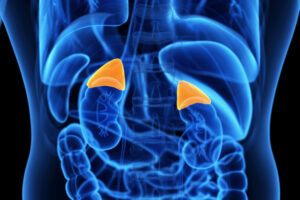by Tay Gabbidon | Jul 13, 2023 | Blog, Nutrition, Science, Uncategorized
HIGH CORTISOL IN WOMEN
Welcome to our discussion on the impact of high cortisol levels on female hormonal health, particularly for women aged 35 and above. Cortisol, often referred to as the “stress hormone,” plays a crucial role in our body’s response to stress. While cortisol is essential for our survival, chronically elevated levels can lead to various health issues, particularly in women. On top of that, it can literally change the shape of a women’s body, robbing it of it’s natural beauty.
When cortisol levels remain consistently high, it can disrupt the delicate balance of hormones in a woman’s body. This hormonal imbalance can have a significant impact on female reproductive health. As women age, hormone levels fluctuate, and high cortisol levels can exacerbate these changes, causing a range of problems.
Let’s look at the 10 biggest signs to look out for when identifying high cortisol levels in women.

#1. WEIGHT GAIN
When cortisol levels are consistently elevated, it can lead to weight gain, particularly in the abdominal area. This is because cortisol promotes the storage of fat in the abdominal region, resulting in a more apple-shaped body. Cortisol interferes with the functioning of the thyroid, which plays a vital role in regulating metabolism and energy levels. This disruption can lead to symptoms such as fatigue, weight gain, and difficulty losing weight, which are often experienced by women.
Visceral fat, which is the fat that surrounds the organs in the abdominal cavity, is particularly influenced by high cortisol levels. This type of fat is metabolically active and can increase the risk of various health issues, including cardiovascular disease, type 2 diabetes, and metabolic syndrome. The accumulation of visceral fat is often associated with high cortisol levels, which breaks down muscle protein and converts protein into glucose, leading to increased fat storage.
#2. BLOOD SUGAR IMBALANCES
Cortisol plays a crucial role in regulating blood sugar levels by promoting the breakdown of glycogen into glucose in the liver. This process, known as glycogenolysis, increases the amount of glucose in the bloodstream, providing a quick source of energy to deal with the perceived threat or stressor.
However, prolonged or chronic high cortisol levels can disrupt this delicate balance. Cortisol can interfere with the action of insulin, a hormone that helps regulate blood sugar levels by facilitating the uptake of glucose into cells. When cortisol levels are consistently elevated, it can lead to insulin resistance, where the cells become less responsive to the effects of insulin. This can result in higher blood sugar levels, as the glucose is unable to enter the cells efficiently. Over time, this can contribute to the development of conditions such as type 2 diabetes.
#3. APPETITE CRAVINGS
The goal of cortisol in relation to food cravings is to provide the body with a quick source of energy. When cortisol levels are elevated, the body perceives it as a signal of stress or danger, and it prepares for a fight-or-flight response. In this state, the body craves foods that are high in sugar and carbohydrates because they can be quickly converted into energy. These “comfort foods” can provide a temporary sense of relief and pleasure.
Additionally, high cortisol levels can cause the body to lose minerals such as magnesium and potassium. These minerals are essential for maintaining proper bodily functions, including the regulation of appetite and cravings. When cortisol levels are elevated, the body excretes more minerals through urine, leading to deficiencies. This can contribute to craving things like salt and red meat as the body tries to compensate for the loss of minerals.

#4. FREQUENT INFECTIONS
Cortisol helps regulate the body’s immune response but when levels are elevated for prolonged periods, it can suppress the immune system. Therefore, it can hinder the body’s ability to fight off infections and illnesses.
High cortisol levels can lead to a decrease in the production of white blood cells, which are crucial for immune defense. These cells play a vital role in identifying and destroying harmful pathogens. High cortisol levels can impair the production and function of these cells, leaving the body more vulnerable to infections like colds & flus.
Additionally, cortisol can interfere with the inflammatory response. Inflammation is a natural defense mechanism that helps the body fight off infections. However, excessive cortisol can dampen this response, making it harder for the immune system to effectively combat pathogens. This can result in a higher likelihood of frequent infections and illnesses.
#5. MENSTRUAL PERIOD
When cortisol levels are high, it can affect the hypothalamus, a part of the brain that plays a crucial role in regulating the menstrual cycle. In this situation, cortisol stimulates the release of corticotropin-releasing hormone (CRH) from the hypothalamus. CRH then signals the pituitary gland to release adrenocorticotropic hormone (ACTH), which further stimulates the production of cortisol.
The release of CRH also has an inhibitory effect on the release of gonadotropin hormone-releasing hormone (GnRH) from the hypothalamus. GnRH is responsible for triggering the release of follicle-stimulating hormone (FSH) and luteinizing hormone (LH) from the pituitary gland, which are essential for the development and release of eggs from the ovaries. When GnRH is suppressed, it disrupts the normal hormonal cascade, leading to irregular or absent menstrual cycles.
In addition to affecting the hypothalamus, high cortisol levels can also impact the ovaries directly. Cortisol can interfere with the production and function of estrogen and progesterone, two key hormones involved in the menstrual cycle. This disruption can further contribute to irregularities in the menstrual cycle and may even lead to conditions such as polycystic ovary syndrome (PCOS) or amenorrhea.
#6. OSTEOPOROSIS
In the United States, 8 million women have osteoporosis compared to 2 million men. In the United Kingdom, 21.9% of women compared to 6.7% of men are estimated to suffer from the disease. As you can see, osteoporosis is more of a threat for women.
Cortisol can interfere with the normal process of bone remodeling in women particularly. It can suppress the activity of osteoblasts, which are responsible for bone formation, while promoting the activity of osteoclasts, which break down bone tissue. This imbalance can result in a net loss of bone density over time, leading to osteoporosis.
Additionally, high cortisol levels can affect the absorption and metabolism of calcium, an essential mineral for maintaining bone health. Cortisol can decrease the absorption of calcium from the intestines and increase its excretion through the kidneys. This can further contribute to a decrease in bone density and increase the risk of osteoporosis. It is important to manage stress and maintain healthy cortisol levels to protect bone health.
#7. MUSCLE WEAKNESS
High cortisol levels in women causes muscle weakness by promoting protein breakdown and inhibiting muscle growth. This can lead to a loss of muscle mass and strength. Additionally, cortisol can redistribute fat to the abdominal area, resulting in a bigger belly. It can also lead to a flattening of the buttocks due to the breakdown of muscle tissue in that area. A nightmare for any women looking to build or maintain a healthy, feminine figure!
When cortisol levels are high, the body enters a catabolic state, breaking down muscle protein for energy. This can result in muscle weakness and a decrease in overall muscle mass. The breakdown of muscle protein also releases amino acids, which can be converted into glucose by the liver, leading to increased blood sugar levels.
Furthermore, high cortisol levels can impair the production of growth hormone, which is essential for muscle growth and repair. This further contributes to muscle weakness and loss of muscle mass. Additionally, cortisol can increase the production of enzymes that break down collagen, a protein that provides structure to muscles and connective tissues.
#8. EASY BRUISING
High cortisol levels can cause easy bruising by weakening blood vessels and impairing the body’s ability to repair them. When cortisol levels are elevated, collagen production is reduced, making blood vessels more fragile and prone to damage. Additionally, cortisol can impair the function of platelets, which are responsible for clotting and preventing excessive bleeding. This combination of weakened blood vessels and impaired clotting mechanisms can lead to easy bruising even from minor injuries.
Furthermore, high cortisol levels can also increase inflammation in the body, which can further contribute to easy bruising. Inflammation can weaken blood vessel walls and make them more susceptible to damage. Additionally, inflammation can impair the body’s ability to repair damaged blood vessels, prolonging the healing process and increasing the likelihood of bruising.
#9. SLOW HEALING
High cortisol in women slows down the body’s healing process by suppressing the immune system and reducing inflammation. This can result in delayed wound healing and prolonged recovery times.
As previously mentioned, high cortisol disrupts the balance of other hormones in the body, such as growth hormone and testosterone, which are important for tissue repair and regeneration. Corticosteroids, synthetic versions of cortisol, are often prescribed to reduce inflammation in certain medical conditions. However, prolonged or excessive use of corticosteroids can lead to high cortisol levels and subsequently hinder the body’s healing abilities. It is important to manage stress levels and seek medical advice to maintain a healthy cortisol balance for optimal healing.

#10. INSOMNIA
High cortisol levels can cause insomnia by disrupting the sleep/wake cycle regulated by the pineal gland. The pineal gland produces melatonin, a hormone that helps regulate sleep. When cortisol levels are high, it can interfere with the production of melatonin, leading to difficulty falling asleep or staying asleep.
Additionally, high cortisol levels can increase alertness and arousal, making it harder to relax and fall asleep. Cortisol is released in response to stress, so chronic stress can lead to consistently elevated cortisol levels, further exacerbating insomnia.
To improve sleep and reduce cortisol levels, it is important to manage stress through relaxation techniques, regular exercise, and a healthy lifestyle. Creating a calming bedtime routine and ensuring a comfortable sleep environment can also help promote better sleep.
SOLUTIONS
Unfortunately, there isn’t a magic pill, or a one-step solution that you can take to keep your cortisol levels in check. As most things that apply to living a healthy lifestyle, you will need a well rounded approach and improving your situation won’t happen overnight. Here are some things that you should consider doing to support healthy cortisol levels within the body:
- Get enough sleep – aim for 7-9 hours per night to help regulate cortisol levels and promote overall well-being.
- Practice stress management techniques like deep breathing, meditation, or yoga to reduce cortisol production.
- Engage in regular exercise, such as walking or swimming, to help lower cortisol levels and improve mood.
- Eat a balanced diet rich in fruits, vegetables, and whole grains, while limiting processed foods and sugar, which can contribute to cortisol spikes.
- Prioritize relaxation and self-care activities, such as taking baths, reading, or listening to music, to help lower cortisol levels and promote a sense of calm.
- Limit caffeine intake, as it can stimulate cortisol production and contribute to elevated stress levels.
- Maintain a healthy work-life balance to reduce chronic stress and keep cortisol levels in check.
- Stay hydrated by drinking enough water throughout the day, as dehydration can increase cortisol levels.
- Incorporate stress-reducing supplements like ashwagandha or magnesium into your routine, after consulting with a healthcare professional.
- Seek social support from friends, family, or support groups to help manage stress and keep cortisol levels low.

REFERENCES:
https://pubmed.ncbi.nlm.nih.gov/27345309/
https://www.ncbi.nlm.nih.gov/pmc/articles/PMC4688585/
https://pubmed.ncbi.nlm.nih.gov/14671189/
https://www.thearthritisconnection.com/rheumatoid-arthritis/cortisol-and-bone-loss#:~:text=Elevated%20cortisol%20levels%20interfere%20with,an%20increased%20risk%20for%20osteoporosis.
Did you enjoy this article? Try these!
Why is Adrenal Fatigue so Difficult for Women? – https://immortal-training.com/why-is-adrenal-fatigue-so-dangerous-for-women/
Healing Leaky Gut Syndrome to Restore Hormonal Balance – https://immortal-training.com/healing-leaky-gut-syndrome-to-restore-hormonal-balance/
by Tay Gabbidon | Apr 6, 2023 | Blog, Exercises, Nutrition, Science, Uncategorized
Adrenal fatigue in women and men occurs when the body’s adrenal glands cannot cope with the demands of stress. It is a common health problem that affects millions of people worldwide. It can manifest as a range of symptoms, from fatigue and weakness to low blood pressure and mood swings. Adrenal fatigue is often misdiagnosed due to its vague symptoms, but with proper attention and management, it is treatable.
In this article, we will explore the causes, symptoms, and treatments of adrenal fatigue. We will also go through practical tips to manage stress and prevent adrenal exhaustion. Whether you’re struggling with adrenal fatigue or seeking more knowledge on this topic, this guide will provide you with valuable insights into this health issue.
WHAT IS THE RELATIONSHIP BETWEEN CORTISOL AND THE ADRENAL GLANDS?
Cortisol is produced by the adrenals, and is an important hormone for managing stress levels in the body. During adrenal fatigue, the production of cortisol can become disrupted, leading to a variety of negative effects. Cortisol is necessary for the proper functioning of the body’s stress response system. When it becomes imbalanced, it can lead to fatigue, anxiety, and inflammation.
One of the most significant effects of cortisol disruption in women is its impact on testosterone and estrogen levels. Cortisol and testosterone share a relationship where increased cortisol production may reduce testosterone levels. This, in turn, can lead to decreased sex drive and issues related to fertility. Additionally, cortisol and estrogen also have a complicated relationship. An imbalance between the two can lead to issues that range from mood swings to irregular menstrual cycles.
WHY DOES ADRENAL FATIGUE AFFECT WOMEN MORE THAN MEN?
While both men and women can suffer from adrenal fatigue, the condition affects women more severely. The reason for this is the complex hormonal system that women have. Women go through monthly menstrual cycles and pregnancy, which causes a lot of physical and emotional stress on the body. Moreover, stress from work, relationships, and other aspects of life only add fuel to the fire.
When stress becomes chronic, the adrenals are unable to keep up with the cortisol demand, leading to adrenal fatigue. Adrenal fatigue can cause a wide array of symptoms, including brain fog, insomnia, weight gain, and mood disorders. Women with adrenal fatigue may experience intense sugar cravings, which can lead to obesity and type 2 diabetes. Women with adrenal fatigue may also face acute anxiety and depression, which can significantly affect their daily life.
In conclusion, women are not only susceptible to adrenal fatigue because of their complex hormonal systems, but also because multiple stressors they face in life. It is essential to address the condition early on to avoid long-term complications.

WHAT OTHER HORMONES DO THE ADRENALS PRODUCE?
The adrenal glands in women play a vital role in the production of sexual steroidal hormones. These hormones have a significant impact on their overall health and well-being. The three primary steroidal hormones produced by the adrenal glands are estrogen, testosterone and progesterone.
Estrogen helps to regulate the menstrual cycle, maintain bone density, and keep the skin healthy. On the other hand, testosterone assists with the creation of lean muscle mass, the maintenance of a healthy sex drive, and the production of red blood cells.
Progesterone is a hormone that is responsible for various functions in the body, including maintaining pregnancy, regulating menstrual cycles, and balancing estrogen. Adequate levels of progesterone are essential for fertility and a healthy pregnancy. In instances where there is a problem with adrenal function or progesterone production, symptoms may include menstrual irregularities, fertility issues, and changes in mood and energy levels.
RISK FACTORS
With the decline in the production of estrogen and testosterone, women can experience various health issues. For instance, low levels of estrogen can cause osteoporosis, resulting in an increased risk of fractures. It can also lead to hot flashes, night sweats, vaginal dryness, and mood swings. Similarly, a decrease in testosterone production can lead to muscle weakness, low sex drive, and fatigue. To ensure the proper functioning of adrenal hormones in women, it is essential to maintain a balanced diet, engage in regular exercise, and get adequate rest.
Additionally, stress management is vital as stress can impact the production of these hormones negatively. Several lifestyle changes, such as reducing stress levels, eating a balanced diet, and getting plenty of exercise and rest, can help reduce the risk of developing adrenal-related health issues. With the right support, women can maintain a healthy hormonal balance and improve their health and well-being.
HOW DOES MENOPAUSE AFFECT THE ADRENAL GLANDS?
Menopausal women often suffer from a wide variety of symptoms due to hormonal changes in their bodies. These changes can lead to an imbalance in the production of hormones by the adrenal glands, which can cause further health problems. Hormonal support of the adrenals is essential for menopausal women as it helps in maintaining a balanced hormonal level and combats the symptoms of menopause.
The adrenal glands are responsible for the production of adrenal hormones, including cortisol, which helps in managing stress levels in the body. During menopause, the levels of cortisol in the body can drop significantly, leading to a variety of unpleasant symptoms such as anxiety, fatigue, and depression. Hormonal support of the adrenals can help in regulating cortisol levels in the body, which, in turn, can alleviate the symptoms of menopause.
Apart from cortisol, the adrenal glands also produce other hormones such as DHEA, which plays a crucial role in maintaining bone density in the body. During menopause, the levels of DHEA can decrease, which can lead to a higher risk of osteoporosis. Hormonal support of the adrenals can help in keeping the levels of DHEA at a healthy level, thereby reducing the risk of bone loss and increasing bone density. Hence, Hormonal support of the adrenals is critical for menopausal women to maintain overall health and well-being.
WHAT ARE THE BEST WAYS TO CURE ADRENAL FATIGUE IN WOMEN?
Fortunately, there are several lifestyle changes that women can make to help cure adrenal fatigue. Here are six things that women can do to cure adrenal fatigue:
- Get enough sleep: Women who suffer from adrenal fatigue should make sure to get enough sleep each night. Aim for 7-9 hours of quality sleep per night.
- Manage stress levels: High levels of chronic stress can exacerbate adrenal fatigue. Women should find ways to manage their stress levels, such as through meditation, deep breathing exercises, or yoga.
- Exercise regularly: Exercise is a great way to reduce stress levels and improve overall health. Women should aim for at least 30 minutes of moderate exercise per day.
- Eat a balanced diet: A balanced diet that is rich in nutrients is essential for curing adrenal fatigue. Women should focus on eating plenty of fruits, vegetables, and lean proteins.
- Limit caffeine and sugar intake: Caffeine and sugar can disrupt hormone levels and exacerbate adrenal fatigue. Women should aim to limit their intake of these substances.
- Take supplements: Some supplements, such as vitamin C, B vitamins, and magnesium, can help reduce symptoms of adrenal fatigue. Women should talk to their doctor about which supplements may be right for them.
WHAT ARE THE BEST SUPPLEMENTS FOR WOMEN TO TAKE FOR ADRENAL SUPPORT?
The following supplements are some of the best that women can take to help cure adrenal fatigue.
- Ashwagandha: This herb has been shown to reduce cortisol levels, which helps to manage stress and fatigue associated with adrenal fatigue. Additionally, ashwagandha has been found to improve sleep quality and reduce anxiety, both of which are common symptoms of adrenal fatigue.
- Magnesium: Magnesium is an essential mineral that has been found to help lower cortisol levels and improve energy levels. It can also help to improve sleep, reduce anxiety, and regulate blood sugar levels, all of which are important for managing adrenal fatigue.
- Vitamin C: Adequate vitamin C intake is crucial for adrenal health. This vitamin is involved in the production of cortisol and can help to reduce stress levels in the body. It is also a powerful antioxidant that can help to protect the adrenal glands from damage caused by free radicals.
- B-complex vitamins: B-vitamins are involved in energy production and play a critical role in adrenal function. Supplementing with a B-complex vitamin can help to improve mood, reduce fatigue, and enhance mental clarity, all of which can alleviate adrenal fatigue symptoms. By including these supplements in a healthy diet and lifestyle, women can support their adrenal health and combat the symptoms of adrenal fatigue. It is always important to consult with a healthcare professional before starting any new supplement regimen.
References:
https://www.ncbi.nlm.nih.gov/pmc/articles/PMC4417336/
https://www.ncbi.nlm.nih.gov/pmc/articles/PMC2902103/#
https://www.ncbi.nlm.nih.gov/pmc/articles/PMC3573577/
If you enjoyed this article, here’s another:
Optimising Strength Training & Diet Around Your Menstrual Cycle – https://immortal-training.com/strength-training-and-dieting-throughout-your-menstrual-cycle/
by Tay Gabbidon | Mar 15, 2023 | Blog, Nutrition, Science, Uncategorized
WHAT ARE THE MAIN CAUSES OF BELLY FAT IN WOMEN?
There are many causes for belly fat storage in women, but in this article we will focus on the five biggest, as they are completely different for women than they are for men.
In my experience and research, I have found that the most common problems that women face have to do with one, or more of the following:
- Thyroidal minerals
- Calories
- Protein
- Vitamin D, and/or
- Sleeping patterns
THYROID MINERALS
WHAT ROLE DOES THE THYROID PLAY IN BELLY FAT STORAGE FOR WOMEN?
Thyroid minerals seem to play a much bigger role in weight loss in women than it does for men. Studies show that one in ten men are affected by thyroid issues, compared to one in ten women. The American Thyroid Association estimates that five to eight women are affected by Hashimoto’s to every one man.
THYROID HORMONES
Our thyroids produce a hormone known as T4 (thyroxine), which gets converted into T3 (triiodothyronine). T3 is the active thyroid hormone that acts on the tissues & cells in our bodies to control metabolism. It does this by increasing oxygen in the mitochondria that causes thermogenesis (burning of fat). T3 also plays a vital role in metabolising glucose/carbohydrates.
The inability to produce adequate levels of T3 will make it difficult to efficiently burn glucose in the cell. Glucose eventually gets converted into fat in the liver through a process called de novo lipogenesis (storing of fat), and liver fat accumulates to… guess what… belly fat.
HOW TO HACK YOUR THYROID
Iodine is critical for creating thyroid hormone. In supplement form it is usually sold in the form of sea kelp, but seafood, and seaweed are the best food sources.
When the thyroid converts iodine it also creates hydrogen peroxide, which can can trigger symptoms in people with autoimmune conditions, such as Hashimoto’s. Selenium is a mineral that is needed for the conversion of T4 into T3 that also neutralises hydrogen peroxide, so it should be taken alongside iodine.
Zinc is another important thyroid mineral, which needed to trigger the thyroid hormone receptors in the hypothalamus gland of the brain.

LOW CALORIE DIETS
HOW DO LOW CALORIE DIETS CAUSE BELLY FAT IN WOMEN?
Studies show that women are more likely to go low-cal than men. Even though staying in a calorie deficit is important for weight loss dropping too many can be counterproductive.
When calories drop too low the body increases thyroid stimulating hormone (TSH) to make more thyroid, but instead of converting T4 to T3 it starts producing reverse T3. Reverse T3 blocks the thyroid receptors, so that normal T3 cannot bind. This makes a slow metabolism even slower.
To avoid creating too much reverse T3 you should keep your deficit within the 200-500kcal range, and go back to baseline every 4-5 days.
NOT GETTING ENOUGH PROTEIN
Micronutrients are those that have calories, which means they give us energy. Besides carbohydrates, and fats, protein is one of the three macronutrients. Protein is needed to build and repair muscles & bones, and to make hormones & enzymes.
That means it can increase lean body mass (LBM). The more LBM the higher the basal metabolic rate (BMR), which is the amount of calories needed to maintain a person’s bodyweight. Our BMR is responsible for 60-70% of the calories we burn. Therefore, lean body mass is directly linked to metabolic health. The higher the lean body mass, the more calories burned at rest.
Protein also burns more calories during digestion than any other food, and is more satiating, which means you’re less likely to binge on crap food.
Women should consume 1.5 grams of protein per 1 kilogram of bodyweight per day, while men need 2 grams per kilo.
VITAMIN D
IS VITAMIN D DEFICIENCY ONE OF THE MAIN CAUSES OF BELLY FAT IN WOMEN?
Despite the name, Vitamin D is actually a hormone. It is the only hormone that our bodies can’t create on its own. Vitamin D must be consumed through food, or obtained through sunlight.
In a Study from the American Journal of Clinical Medicine, named Effects of Weight Loss on Serum Vitamin D in Menopausal Women, 439 women aged 50-75 took part in a year long trial. The women were split into four groups: 1) diet only; 2) exercise & diet; 3) exercise only, and; 4) a controlled group.
The study found that the women who lost 5-10% of their bodyweight had an increase in Vitamin D3, but when they lost 15% that number tripled. What does this mean?
Vitamin D is fat soluble, so it will be released during thermogenesis. When this happens, uncoupling protein-3 also gets released, which stops excess fat from getting into cells. Instead the fat gets burnt, or excreted. The conclusion suggests that metabolism of Vitamin D.
STRESS
HOW IS STRESS ONE OF THE MAIN CAUSES OF BELLY FAT IN WOMEN?
A study published in the Journal of Brain & Behaviour found that women are two times more likely to suffer from anxiety & stress than men.
Stress can be caused by a lot of things, but the most common is a lack of sleep. With a lot of people, a lack of sleep also leads consuming too much caffeine during the day. Both of these issues can contribute to adrenal fatigue.

The adrenal glands sit jus above the kidneys. Stress causes adrenaline, and cortisol (stress hormone) to be released from the adrenal glands. There are four times more cortisol receptors in the abdominals compared to the rest of the body, so stress eating means that a considerable amount of that chocolate cake is going to be stored around the mid-section.
The remedy for this is to make sure you get 7-9 hours sleep per night, and to incorporate practices into your life that help reduce stress, such as meditation, yoga, nature walks, warm, candle-lit baths, etc.
REFERENCES:
Study – JAMA: https://jamanetwork.com/journals/jama/fullarticle/1103993
Study – American Journal of Clinical Nutrition: https://pubmed.ncbi.nlm.nih.gov/14592784/
https://academic.oup.com/ajcn/article/94/1/95/4597994?login=false
Journal of Biological Medicine: https://www.ncbi.nlm.nih.gov/pmc/articles/PMC4966724/
Journal of Brain & Behaviour: https://onlinelibrary.wiley.com/doi/full/10.1002/brb3.497

by Tay Gabbidon | Jan 10, 2022 | Blog, Nutrition, Uncategorized

If you want to trigger me, just say that saturated fat is unhealthy. I’m here to show you that it is not. In fact, including saturated fat in our diets is essential for maintaining an optimal biological state of well-being.
WHAT ARE THE BENEFITS OF SATURATED FAT?
Saturated fat is needed for:
- Mental development – the brain is made up of mostly saturated fat and cholesterol.
- Bone development – saturated fats metabolise calcium.
- Cardiovascular function – the lungs are coated with fatty acids that are saturated.
- The nervous system – as in the brain the nervous system is largely made up of saturated fats.
- Hormonal support – saturated fats are the building blocks to making hormones such as testosterone, oestrogen, cortisol, etc.
According to the independent study, A Critical Review of Cardio Disease by Dr Walter Willet from Harvard School of Public Health, we can see that saturated fat is not linked to heart disease and protects against strokes. Daily nut consumption is associated with a 35% decrease in the risk of heart attacks. Consuming full fat dairy is associated with a 60% reduction in risk of type 2 diabetes, lowers high density cholesterol, triglyceride levels and inflammation markers. People that eat egg yolks can reduce the chance of becoming diabetic by 42%. I highly recommend reading Dr Willett’s book, Eat, Drink and Be Healthy: The Harvard Medical School Guide to Healthy Eating if you want to gain more of an understanding of his research.
WHY IS SATURATED FAT SEEN AS UNHEALTHY?
You should never trust the science. Question it always. Lessons learned during the recent COVID pandemic have proven why this approach is most important. The same goes for the scientific understanding of saturated fat.
To understand the history, we must go back to the 1920s to spend time with Dr Charles Best & Dr Frederick Banting, two scientists who earned a Nobel Peace Prize for purifying insulin, making it available for pharmaceutical use. They also made some other interesting discoveries.
Drs Best & Banting were the first scientists to discover an accumulation of fat in and around the organs in diabetics. This discovery lead them to believe that dietary fat was the cause of type 2 diabetes. The development of the infamous food pyramid that was pushed onto the public was a direct result of this. It could be fair to say that certain powerful food corporations were able capitalise on these studies, but that’s a different conversation altogether!
Fortunately, technology has advanced a lot since the 1920s. The science that was missing from their research was the role of the liver. The liver plays a key role in fat metabolism. It is now known that the liver converts sugars into fat to be stored, either as subcutaneous – on the outside of the body – or visceral fat – in and around the organs. In fact, to put it quite simply, body fat is nothing more than stored sugar. Once there is no more room for it to be stored in the liver, the body is forced to store fat in the pancreas. When this happens, a person loses the ability to create insulin on their own. Welcome to type 2 diabetes.
Since the recommendation of ‘low fat’ diets by the bodies that govern food & drugs, we have noticed a 400%+ increase in heart disease, diabetes & obesity. Until the public is completely re-educated about nutrition this problem isn’t going to get better.
ARE THERE DIFFERENT TYPES OF SATURATED FATS?
Palmitic acid is often considered an unhealthy saturated fat because people often associate it with palm oil, but you will find that the acid (not the oil product) is already a part of our biological make up. Here are the different types of saturated fatty acids and their benefits:
- Caprylic acid – found in coconut oil, dairy, breast milk, nuts. Great for the immune system, acne, and is anti-viral.
- Lauric acid – found in coconut oil, breast milk. Needed for the immune system and is anti-viral.
- Palmitic acid – abundant in fish, nuts, seeds, animal products. 50% of cell membrane is made up palmitic acid.
- Butyric acid – found in butter and vegetable sources. This is the main fatty acid that feeds cells in the colon.
WHICH FATS SHOULD I AVOID?
We can put lipids (fats) into three categories – saturated, unsaturated and trans.
Unsaturated fats – EPAs & DHAs – are the omegas. These often get promoted as ‘healthy fats’, but you should now understand that saturated fat is just as important.
Trans fats increase the risk of heart disease and other health problems. They are found in hydrogenated foods. This is when a hydrogen atom is introduced to an oil to solidify it, preventing it from going rank. Margarine often disguised as ‘spreadable butter’ is a form of trans fat. Trans fats can also be found in fast food, microwave meals and other processed foods. We should avoid these fats at all costs.
The rule that I follow says, if you can dig it from the ground, pick it from a tree or plant, or slaughter it and it’s still in its unaltered state then it is OK to eat. The most important part of that statement is that it is still in its unaltered state. Meaning unrefined and unprocessed.
References:
Nutritional Epidemiology, Dr Walter Willet
Dr Charles Best & Dr Frederick Banting:
https://en.wikipedia.org/wiki/Frederick_Banting
Study comparing consumption of Saturated Fats vs Unsaturated Fats:
http://www.bmj.com/content/353/bmj.i1246 Astrup, A., Dyerberg, J., Elwood, P., Hermansen, K., Hu, F.B., Jakobsen, M.U., …Willett, W.C. (2011). The role of reducing intakes of saturated fat in the prevention of cardiovascular disease: Where does the evidence stand in 2010? [PDF]. Am J Clin Nutr, 93(4): 684–8. doi: 10.3945/ ajcn.110.004622
For help with own nutrition go here:
https://immortal-training.com/book-a-consultation/

by Tay Gabbidon | Dec 21, 2021 | Blog, Nutrition, Recipes

RAW CHOCOLATE KETO SHORTBREAD RECIPE
WHAT IS RAW CHOCOLATE KETO SHORTBREAD?
Raw Chocolate Keto Shortbread is a healthy dessert recipe that is ideal for obese and diabetic people who struggle to lose weight.
Prep Time: 15 mins
Cook Time: 1 hour
Servings: Serves: 8-10
INGREDIENTS
100g Ground Almonds (1 cup)
100g Dried Coconut / Desiccated Coconut (1
Cup)
2 TBSP Cashew Nut Butter (or alternative)
1 TBSP Sweetener
1 Pinch Salt
100g 85% chocolate
1 TBSP Coconut Oil
DIRECTIONS
In a food processor place ground almonds, dried coconut, cashew butter, sweetener and salt and blend until a bound consistency has formed (about 1-2 mins.
In a silicon mould or a greased dish press down the mixture to form a flat base. Place in the freezer for about 30 minutes until solid In a glass bowl over a pan of boiling water melt your chocolate and coconut oil together and stir until fully combined.
Now pour directly on to the shortbread base and place in freezer for about an hour until set.
Remove from the freezer and allow to stand for about 15-20 minutes before using a sharp knife to cut squares. Store inside a sealed container in the fridge.

by Tay Gabbidon | Dec 21, 2021 | Blog, Nutrition, Recipes
 What Are Keto Crackers?
What Are Keto Crackers?
Keto crackers are carb-free crackers that are great tasting and ideal for diabetics and people that want to lose weight in the form of body fat.
Prep Time: 10 minutes
Cook Time: 20 minutes
Servings: Servings 36
INGREDIENTS
1 cup almond flour
1/2 cup hemp hearts
1/2 cup coconut flour plus extra for rolling the
dough
3 teaspoons baking powder
1 teaspoon xanthan gum
1/4 teaspoon baking soda
1/2 teaspoon salt for topping
6 tablespoons cold salted butter – very cold
4 tablespoons salted butter melted
2 tablespoons olive oil
2/3 cup ice water
DIRECTIONS
Preheat oven to 205°C.
Put the almond flour, hemp hearts, coconut flour, baking powder, baking soda, and salt in a bowl. Grate the chilled butter, stirring it into the flours. Stir gently with a big spoon to ensure the butter is coated with flour and you can see butter shreds throughout your coconut flour mixture. Add the olive oil and stir gently to combine, then add the water. Let the mixture stand in the refrigerator for at
least 30 minutes.
Dust a sheet of parchment with coconut flour. Roll the chilled dough between sheets of baking parchment until it is about ¼ -inch thick. Cut the dough in the desired shapes. Bake the crackers on the bottom parchment sheet for 15-20 minutes or until golden brown. Add 1/2 teaspoon of salt to melted butter and brush the crackers while they are hot.
Turn oven off and place back in the oven for 5 minutes. Let cool.













Recent Comments